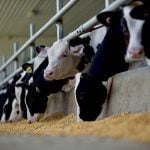Cattle get lame for a lot of reasons, including injury, poor conformation, grain overload, mycotoxins (e.g. ergot) and bacterial infection. Different types of lameness need to be treated differently. Antibiotic treatment only helps if a bacterial infection is involved. Lameness is the second leading reason (behind bovine respiratory disease) that feedlot cattle are pulled and given […] Read more












